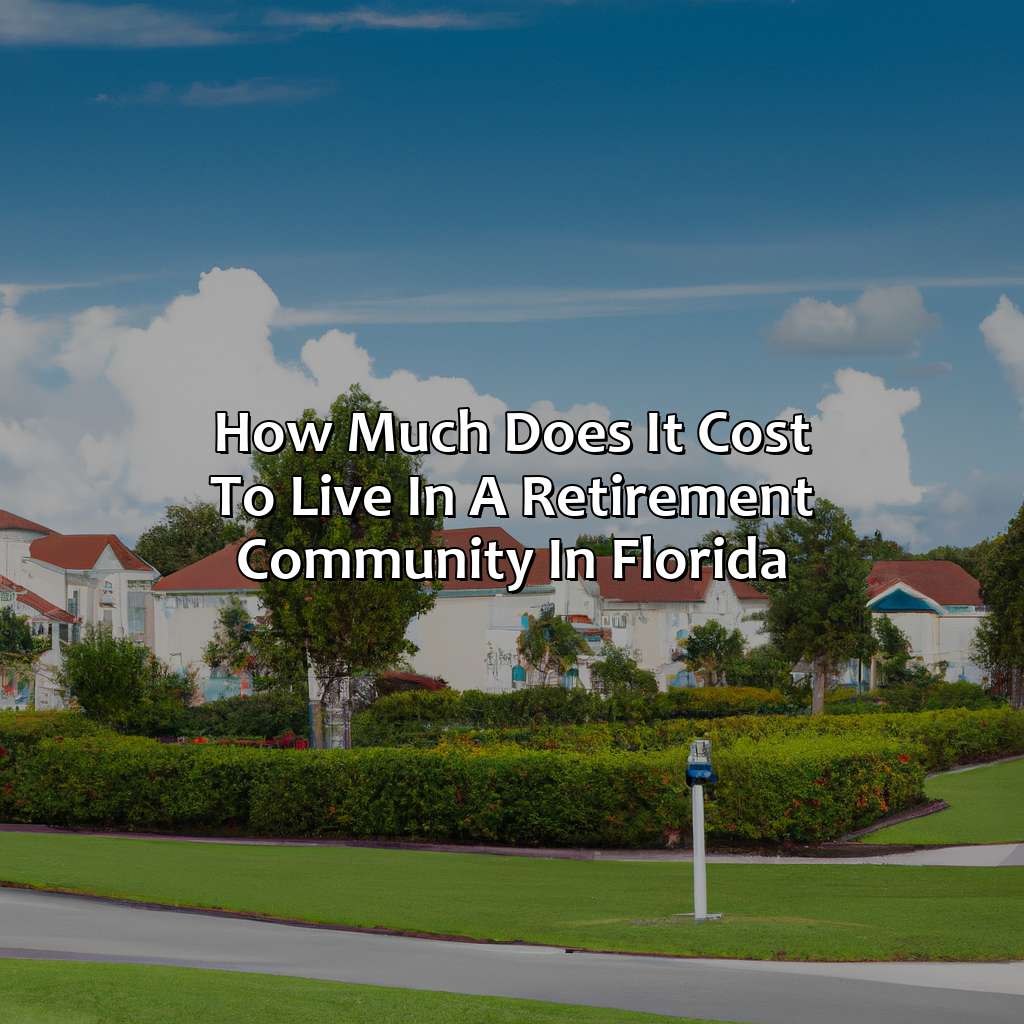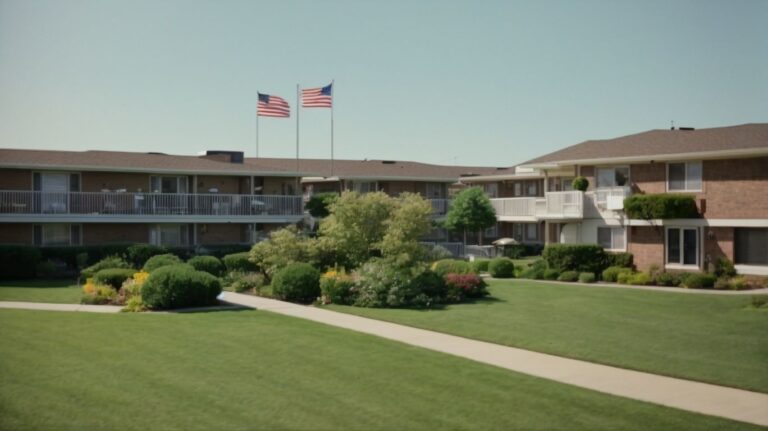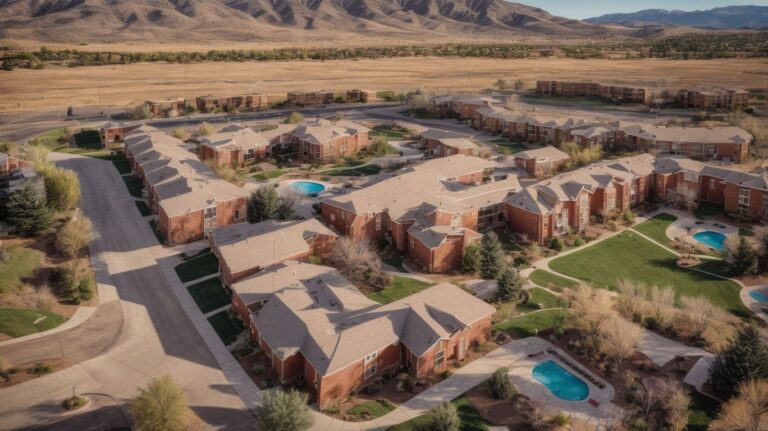How Much Does It Cost To Live In A Retirement Community In Florida?
Key Takeaway:
- Retirement communities in Florida offer different types of accommodation and services, ranging from independent living to assisted living and memory care. The cost of living in these communities varies depending on the type of accommodation chosen.
- Monthly fees in retirement communities in Florida typically include rent, utilities, housekeeping, maintenance, and access to amenities and services such as meals, transportation, and healthcare. Entry fees and deposits may also be required at some communities.
- In addition to monthly fees, there are other expenses to consider when living in a retirement community in Florida, such as healthcare and insurance costs, entertainment and dining expenses, and personal care expenses.
Are you thinking about relocating to a retirement community in Florida? You’ll be glad to know that, with careful research, you can find a retirement community that fits your budget. In this article, you’ll learn how much it costs to live in a retirement community in Florida and what amenities you can expect.
Retirement Communities in Florida
Retirement planning in Florida? Learn about different types of retirement communities and the amenities and services they offer. We’ve got you covered! Here’s a comprehensive overview of the options available to you. Don’t miss out – start planning for your retirement now!

Image credits: retiregenz.com by James Duncun
Types of Retirement Communities
Retirement Communities encompass various housing options that cater to seniors’ needs. The costs and conveniences linked with each vary significantly, offering an expansive range of living alternatives tailored to meet aging adults’ lifestyle requirements.
The different types of Retirement Communities are:
- Active Adult Communities
- Independent Living Communities
- Assisted Living Facilities
- Nursing Homes
- Memory Care Communities
- Continuing Care Retirement Communities (CCRCs)
Active adult communities promote active living with recreational activities, social events, and amenities catered to people aged 55 and above. Independent living facilities provide retired folks social interaction, support services, maintenance-free accommodation, and first-class cuisine without healthcare services. Assisted living is an alternative for those who need aid with hygiene, meals preparation or administration of medication. Nursing homes tend to healthcare needs for folks with underlying medical conditions around the clock. Memory care communities cater exclusively to Alzheimer’s patients by providing secured accommodations, personal care assistance, health monitoring, and recreational activities.
With a variety of housing alternatives available in the retirement community market, it’s crucial to explore those that resonate best with our lifestyles but also fall within our budgetary constraints.
Fear Missing Out (FOMO) on enjoyable retirement years can be overwhelming; however, considering all these options allows one the best chance at finding a fit for our lifestyle and health-care needs while still meeting economic goals for the future.
Retirement communities in Florida offer more activities than your average cruise ship, minus the sea-sickness and questionable buffets.
Amenities and Services Offered
Retirement Communities in Florida: The Perks of Living in Such an Establishment
Life at a retirement community in Florida comes with numerous amenities and services that are worth discussing. These conveniences can lead to a much more fulfilling and satisfying life than one could enjoy outside such a community.
- Meal services for residents are available, usually in the form of a dining room or restaurant-style setting.
- On-site healthcare is also offered, including physical therapy rooms, medical exams, and nursing staff available throughout the day and night.
- Social events and recreational activities like golf courses, swimming pools, fitness classes create an opportunity for residents to make new friends, stay active physically and mentally.
- Regular housekeeping services ensure that cleaning tasks do not consume the time or energy of residents.
- Transportation options such as shuttle buses make it easy for residents to get around without having to own their cars.
- Security measures like gated entryways and security guards give residents peace of mind.
Moreover, some communities have libraries, beauty salons/barber shops or even special amenities like art studios or woodworking shops for individuals who want to pursue their hobbies.
It is important to note that prices vary based on factors such as location within the state, level of luxury provided by the community/experience one seeks. According to Senior Guidance website (seniorguidance.org), The average cost is $2,000 to $4,000 per month depending on independent living vs assisted living options.
Retiring in Florida may cost you an arm and a leg, but at least you’ll have plenty of sunshine to tan them.
Cost of Living in Retirement Communities in Florida
Gaining insight into the Cost of Living in Retirement Communities in Florida requires a closer look. Monthly Fees, Entry Fees, Deposits and other costs can alter your budget. It’s important to understand each expense before making financial commitments.
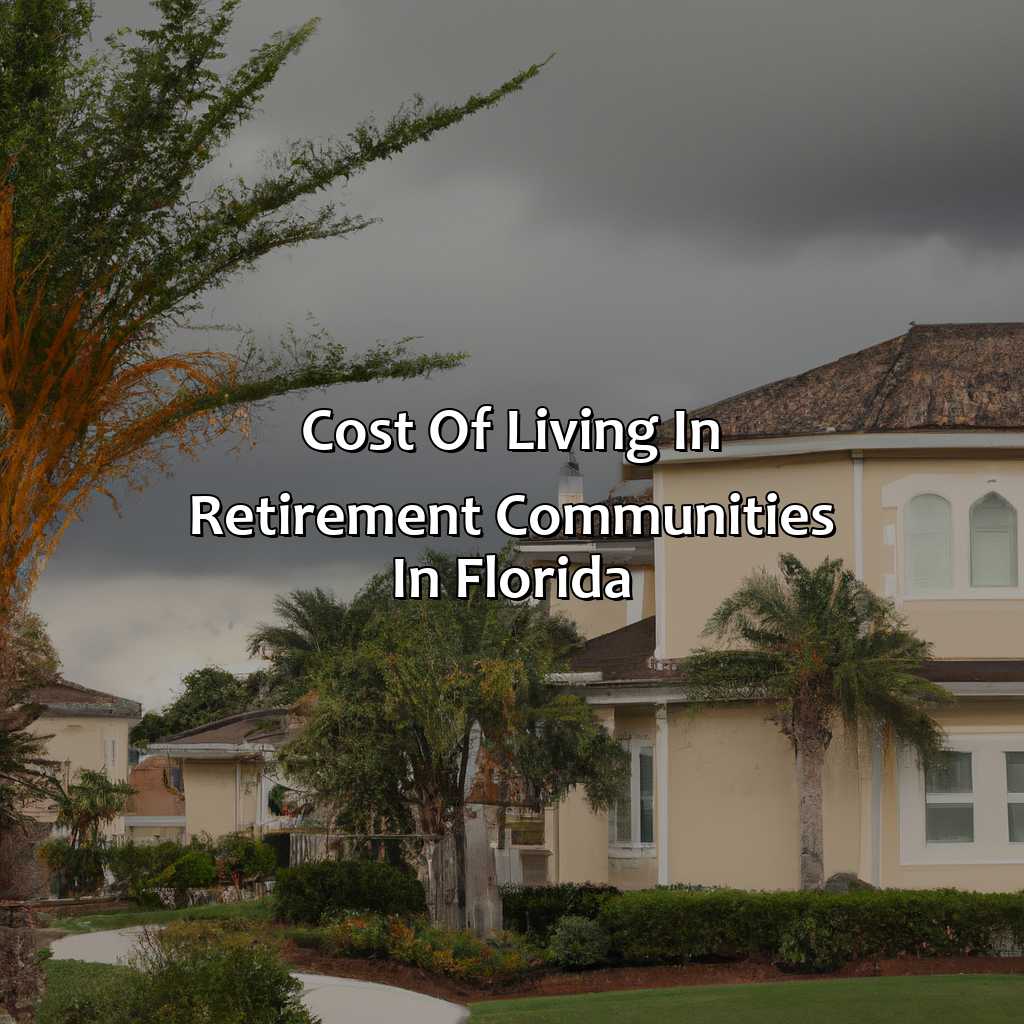
Image credits: retiregenz.com by Harry Washington
Monthly Fee breakdown
When it comes to understanding the expenditures associated with residing in a Florida retirement community, a precise breakdown of monthly fees is essential. Henceforth, let’s have a look at the Monthly Fee Breakdown that provides a detailed overview of all expenses involved in living in these communities.
To get an overview of what to expect and understand the pricing structure of living in a retirement community, take note of this table.
Monthly Fee Breakdown:
| Type | Cost | Inclusions |
|---|---|---|
| Rent | $3,000-$5,000/month | Utilities (excluding phone and cable), maintenance |
| Amenity Fees | $500-$1,000/month | Access to health clubs, pools, golf courses, tennis courts |
| Meal Plans | $300-$600/month/person | 1-3 meals per day depending on availability |
The above table represents actual data based on various retirements communities across Florida. Note that individual amenities may vary from type to type and community to community.
Lastly, make sure to do thorough research before getting into an agreement with any retirement community. To ensure you choose the right one for you with excellent services within budget potential communities can be researched online or through word-of-mouth recommendations.
Therefore, to avoid any unnecessary expenses or hidden costs while living in a retirement community plan your budget accordingly by researching these areas beforehand – residency options like Independent or Assisted Living Residences or Continuing Care Retirement Communities (CCRCs). Also, make sure that when visiting these compounds, ask questions regarding any additional costs such as property taxes and personal caretaker reserved roles that are excluded from monthly fees.
Looks like retirement communities in Florida charge more upfront than a college tuition, but at least you won’t have to worry about taking any finals.
Entry Fees and Deposits
The costs involved in securing a residence within retirement communities are quite substantial, and these costs make up the Entry Fees and Deposits. Here’s what you should know about them:
- The majority of retirement communities require a one-time Entry Fee that can cost tens of thousands of dollars.
- A few communities also have an additional Deposit that is refundable, but requires even more capital upfront.
- It’s important to research various Entrance Fees and Deposits for different areas, facilities and services since they vary greatly across the state.
Furthermore, it’s interesting to note that some Retirement Communities provide alternative payment options while others will waive or reduce their fees for certain residents based on specific conditions. This demonstrates just how varied the cost structures are for senior living arrangements in Florida.
Intriguingly, some well-known retirement communities have seen residents suing management companies over Entry Fees which were considered unjust. While most individuals choose these communities to improve their quality of life post-retirement, the pressure to justify high costs means there‘s considerable risk when it comes to planning one’s finances.
Retirement communities may have higher expenses, but at least you won’t have to worry about mowing the lawn anymore.
Other expenses to consider
Expenses Beyond Basic Living Costs
One must consider various costs while living in retirement communities. These expenses would be beyond basic living costs, such as food, shelter, and healthcare.
- Personal Care Expenses: Many people require personal care services like bathing, dressing, and grooming. These might add up to the monthly expense.
- Entertainment Expenses: Retirement communities usually have provisions for social gatherings and leisure activities. However, these can come at an additional cost to residents.
- Transportation Expenses: Most communities provide transportation services to nearby locations, but if you need to travel out of town or for medical appointments, you would have to make alternate arrangements.
Moreover, other costs like utility bills, home maintenance fees can also add up. Residents should clarify which amenities are included in their monthly fee and which are not.
Residents who opt for a larger community with more amenities could end up facing more costs than they anticipated. Take the example of a couple who opted for a gated community with many facilities. They enjoyed the amenities till they received a huge bill from the community authorities owing to the overuse of water and electricity. It was unclear whether these were additional one-time charges or part of routine bills sent quarterly by the community management. The couple had to negotiate with the authorities before they could be sure that it won’t happen again.
Retirement communities in Florida: where the cost of living goes up, but the golf carts go faster.
Factors Affecting Cost of Living in Retirement Communities in Florida
Want to learn about the cost of living in retirement communities in Florida? Let’s dive into the details. Location, type of accommodation, amenities, and services will all impact the cost. Read on to get a better understanding of each factor and how it influences the cost.
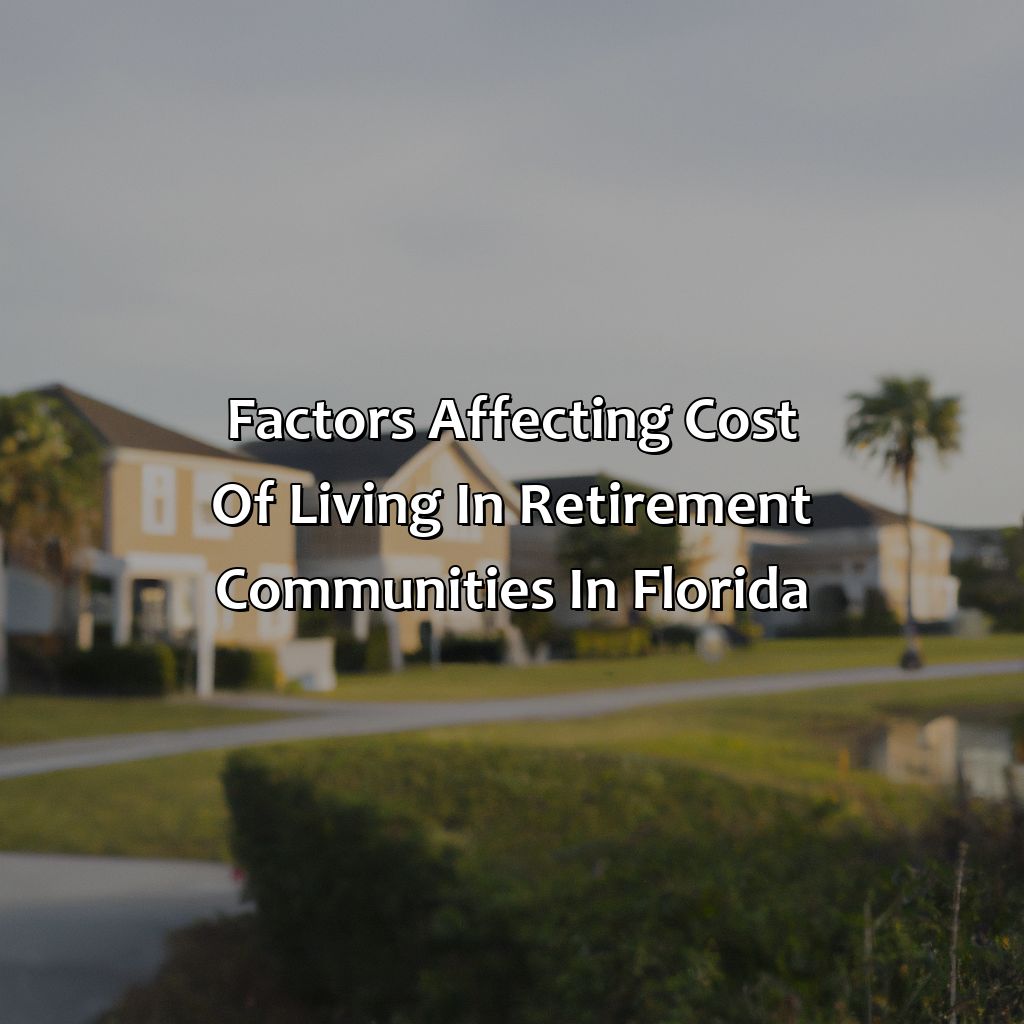
Image credits: retiregenz.com by David Arnold
Location
The impact of location on the cost of living in Florida’s retirement communities is significant. Factors such as proximity to healthcare facilities, shopping centers, and entertainment venues can significantly influence the overall cost of living. Additionally, areas with high demand for senior living tend to have higher costs associated with housing and care services.
It is important to note that there are several regions within Florida that offer varying levels of amenities. For instance, communities located near coastal areas or cities tend to have more luxurious accommodations and higher prices than those in rural areas. As a result, seniors should consider their lifestyle preferences when choosing a location.
Overall area demographics also play a role in determining the cost of living. Regions with high costs of living due to an influx of wealthy residents will therefore likely have higher rates for senior care.
By considering several factors when choosing a retirement community location, seniors can select an option that meets their unique needs while staying within budget. It’s essential to consult with community representatives about available amenities and anticipated expenses before making any commitments.
Don’t miss out on finding the ideal retirement community by overlooking the importance of location. Take time to research and explore all options available to ensure you find the perfect match for your lifestyle and financial situation.
Retirement communities in Florida offer a variety of accommodation options, from cozy apartments to spacious villas, because let’s face it, retirees need their space to practice their dance moves.
Type of Accommodation
Retirement Communities Florida Accommodation Options
There are various types of accommodation available in retirement communities in Florida.
- Studio or Efficiency Units:
These usually contain a single room that serves as a living area, bedroom and kitchenette with a small bathroom. - One-Bedroom Apartments:
This type usually has separate living, sleeping and cooking areas, and might also feature a balcony or terrace. - Two-Bedroom Apartments:
These larger apartments offer two sets of living, sleeping and cooking areas. - Cottages/Houses:
Cottages or houses often offer the most space and privacy, with several rooms spread over one or two levels. Many have outdoor spaces such as patios or gardens. - Assisted Living Units:
Residents in these units require daily assistance from healthcare professionals with activities such as medication management, bathing, dressing and grooming.
Some retirement communities may also have customized options to cater for specific healthcare needs.
It is worth noting that some assisted living facilities within retirement communities allow couples to remain together even if one spouse requires more assistance than the other.
Florida’s first ever registered retirement community was located in St. Petersburg; Sun City Center opened its doors in 1961.
Retirement communities in Florida offer all the amenities you’ll need to ensure that every golden moment of your sunset years is spent in luxury.
Amenities and Services
Distinguishing offerings and benefits
Retirement communities in Florida provide various amenities and services to elderly residents. These features contribute differently to the overall cost of living in the communities.
The following are some of the amenities and services provided by retirement communities:
- Maintenance: Regular and efficient maintenance is imperative for a peaceful environment, including neat landscaping, plumbing, electricity lines, exteriors, and cleaning services.
- Healthcare: Medical support includes skilled nursing care, emergency response systems, medication management assistance, transportation for doctor appointments.
- Recreational Activities: Senior living facilities usually offer daily social events such as card games or movie nights along with access to exercise machines or swimming pools.
- Hospitality services: Retirement homes often have their chefs who prepare meals 3 times a day while accommodating dietary restrictions.
One aspect that may impact the cost of living significantly in retirement communities is transportation. Many establishments offer scheduled shuttles to stores or doctors’ offices; however, expenses can accumulate if one chooses not to use them or desires a more customized transit arrangement.
For those planning on retiring in Florida’s desirable climate without compromising their financial well-being, they can take several measures. Inquire for available discounts on rent or service expenses provided by the community. Consider sharing accommodation space with someone else; this can lower living costs per person and develop a sense of support and companionship. Furthermore, opting for furnished options and downsizing possessions will reduce moving costs while providing an effortless transition into senior housing.
Five Facts About the Cost of Living in a Retirement Community in Florida:
- ✅ The average cost of living in a retirement community in Florida ranges from $2,500 to $7,000 per month. (Source: Caring.com)
- ✅ The cost of living in a retirement community in Florida depends on factors such as location, amenities, and level of care. (Source: Money US News)
- ✅ Some Florida retirement communities have entrance fees ranging from $50,000 to over $1 million. (Source: US News and World Report)
- ✅ Florida offers a homestead exemption for seniors over the age of 65, which can reduce property taxes and the cost of living in a retirement community. (Source: Investopedia)
- ✅ Many retirement communities in Florida offer inclusive packages that may include meals, transportation, and housekeeping services. (Source: A Place for Mom)
FAQs about How Much Does It Cost To Live In A Retirement Community In Florida?
What is the average cost of living in a retirement community in Florida?
The average cost of living in a retirement community in Florida can vary depending on the location, level of care, and amenities offered. On average, you can expect to pay between $2,500 and $6,000 per month for basic services, and up to $10,000 per month for more luxurious accommodations.
What factors can affect the cost of living in a retirement community in Florida?
The cost of living in a retirement community in Florida can be affected by several factors such as location, the type of housing you choose, level of care needed, and amenities offered. Typically, communities located in more desirable areas or that offer more luxurious amenities will be more expensive than those in less desirable areas or with fewer amenities.
Are there any additional costs associated with living in a retirement community in Florida?
Most retirement communities will have additional costs on top of the monthly rent or fee. These may include community fees, meal plans, transportation, and other services. It’s important to get a complete understanding of what is and isn’t included in your monthly fee before signing any agreements.
What is the average age for residents in a retirement community in Florida?
The average age for residents in a retirement community in Florida is typically around 75 to 85 years old. However, some communities may have a wider age range depending on the level of care offered as well as the amenities provided.
Can I use Medicare or Medicaid to pay for a retirement community in Florida?
Generally, Medicare and Medicaid do not cover the cost of living in a retirement community in Florida. However, they may cover some medical expenses or services such as rehabilitation or therapy that are needed while living in a retirement community. It’s important to check with your insurance provider to see what is and isn’t covered.
What are some financing options for living in a retirement community in Florida?
There are several financing options available for those looking to live in a retirement community in Florida. These may include home equity loans or lines of credit, reverse mortgages, or long-term care insurance. It’s important to research and weigh the pros and cons of each option to find one that works best for your individual situation.
